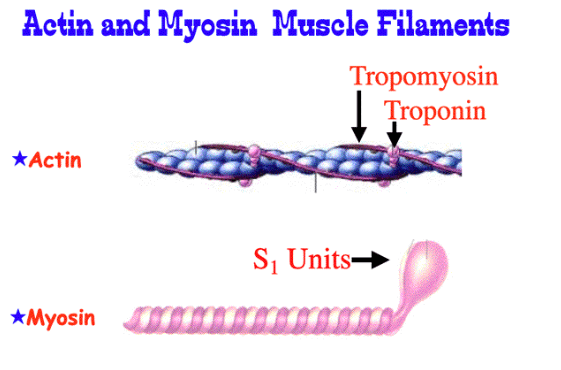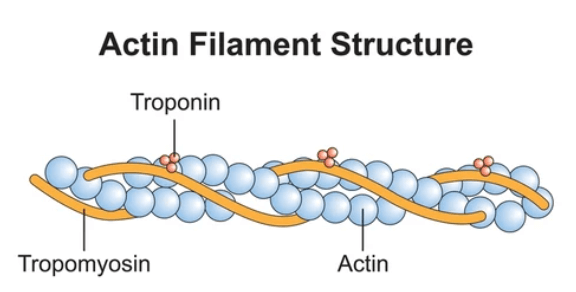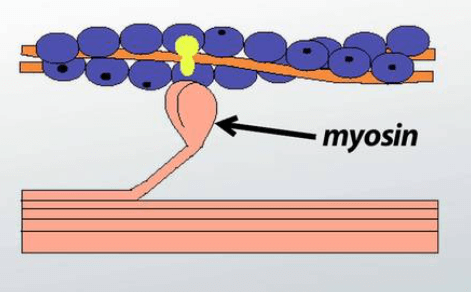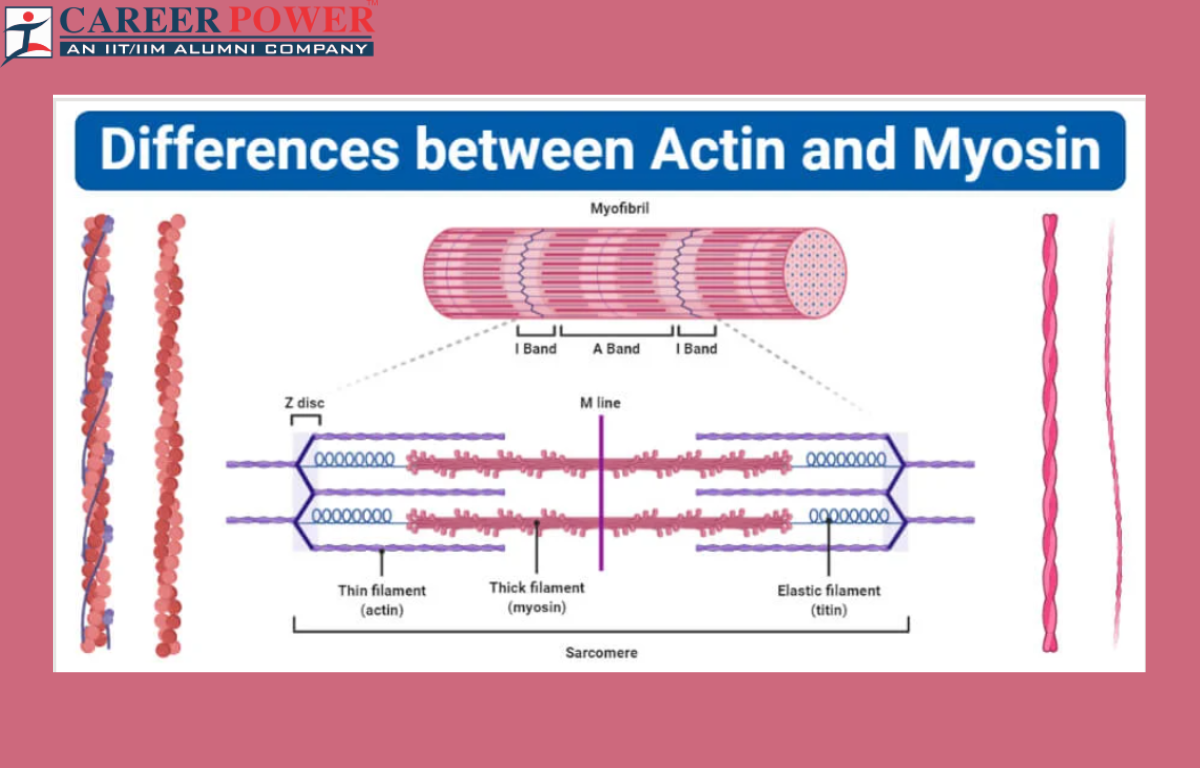Actin and myosin are the two types of proteins found in muscle tissues. Actin provides the track for myosin movement during muscle contraction. Myosin, on the other hand, generates the force needed for muscle contraction by forming cross-bridges with actin and pulling the thin filaments toward the center of the sarcomere. Their roles are fundamental in both muscle Biology and broader cellular functions. Together, the interactions between actin and myosin lead to muscle contraction and movement. We have briefly discussed both actin and myosin and their differences below in the article.
Actin and Myosin
Both actin and myosin are proteins found in muscle tissue and are crucial for globular contraction. Actin is a thin globular protein that forms thin filaments, while myosin is a motor protein that forms thick filaments, pulling them closer together. This interaction between actin and myosin filaments shortens the muscle fibers, leading to muscle contraction. This process is essential for various physiological functions, including movement and maintaining posture.

What is Actin?
Actin is a highly conserved protein found in most Eukaryotic cells. It exists in two forms: G-actin (globular actin) and F-actin (filamentous actin). G-actin molecules can polymerize to form F-actin filaments. These filaments are essential for various cellular activities, such as maintaining cell shape, facilitating cell migration, and supporting the structure of cell protrusions like microvilli.

In muscle cells, actin filaments, along with myosin filaments, are responsible for muscle contraction. During this process, myosin and actin interact, causing muscle fibers to contract and generate movement.
Actin is regulated by several proteins, including actin-binding proteins, which control its polymerization and depolymerization. Actin dynamics are crucial for processes like cytokinesis (cell division), cell signaling, and the formation of specialized cell structures, such as the lamellipodia and filopodia involved in cell motility and the formation of cellular extensions.
What is Myosin?
Myosin is not only crucial for muscle contraction but is also involved in various cellular cellular processes such as cell division, cell motility, and organelle transport within cells. Structurally, myosin molecules have a globular head region that binds to actin filaments and uses energy from ATP hydrolysis to generate the force required for movement.

There are several classes of myosin proteins, each found in different cell types and performing specific functions. For example, myosin II is primarily found in muscle cells and is responsible for muscle contraction. Myosin I is involved in processes like cell membrane protrusion and endocytosis. Myosin V is essential for intracellular transport and movement of organelles along the cytoskeleton.
Researchers continue to study myosin and its functions to better understand cellular processes and develop treatments for various diseases related to muscle and cell motility disorders.
Difference Between Actin and Myosin
Actin and Myosin are both proteins found in muscle tissue and play crucial roles in muscle contraction, but they have distinct functions within the muscle cells. Here we have discussed a few differences between actin and myosin in a tabulated form.
| Difference Between Actin and Myosin | ||
| Aspects | Actin | Myosin |
| Structure | Actin are globular proteins forming microfilaments. | Myosin are motor proteins with long tails and globular heads. |
| Function | Forms thin filaments in muscle cells and provides a track for myosin movement during muscle contraction. | Generates muscle contraction by forming cross-bridges with actin pulling thin filament. |
| Location | Actin is found in thin filaments of myofibrils. | Myosin is found in thick filaments of myofibrils, overlapping with actin filaments. |
| Movement | Provides the pathway along which myosin moves. | Generates force by pulling actin filaments toward the center of the sarcomere. |
| Energy Usage | Actin does not consume ATP directly during muscle contraction. | Myosin requires ATP hydrolysis to generate movement. |
| Filament Type | Actin forms part of the cytoskeleton. | Myosin is involved in muscle contractile machinery. |
| Regulation | Actin is regulated by the troponin-tropomyosin complex in muscle contraction. | Myosin is regulated by photophosphorylation and calcium ions. |
| Role in Muscle | Actin is essential for muscle contraction and movement. | Myosin is critical for muscle contraction and force generation. |
| Molecular Motor | Actin is not a motor protein. | Myosin is a motor protein capable of converting chemical energy into mechanical work. |
| Interaction with ATP | Actin is not directly involved in ATP hydrolysis for movement. | Myosin hydrolyzes ATP to ADP and inorganic phosphate for movement. |
Importance of Actin and Myosin
Actin and myosin are crucial proteins in the human body, playing a fundamental role in muscle contraction and various other cellular processes. Actin and myosin are indispensable for both muscle function and a wide range of cellular activities, making them essential components in the proper functioning of the human body. Actin and myosin are indispensable for muscle function, cellular movement, maintaining cell shape, intracellular transport, and cell signaling, and are associated with various genetic and muscular disorders. Here’s why they are important.
- Muscle Contraction: Actin and myosin work together in muscle fibers to enable muscle contraction. When muscles contract, myosin filaments grab onto actin filaments and pull them, shortening the muscle fiber and generating movement.
- Cellular Movement: Apart from muscles, actin and myosin are involved in cellular movements such as cytokinesis (cell division), cell motility, and the movement of organelles within cells. They enable cells to change shape, move, and carry out essential functions.
- Maintenance of Cell Shape: Actin filaments provide structural support to the cell and help maintain its shape. They form the cell’s cytoskeleton, a network of protein filaments that gives the cell its structure and stability.
- Intracellular Transport: Myosin motors move along actin filaments, transporting cellular cargo to specific locations within the cell. This process is vital for the proper functioning of cells and their organelles.
- Cell Signalling: Actin and myosin are involved in various cell signaling pathways. Changes in the actin cytoskeleton can influence how cells respond to external signals, affecting processes such as growth, differentiation, and apoptosis (cell death).
- Muscle Disorders: Mutations in genes encoding actin and myosin can lead to muscle-related disorders. Understanding these proteins is crucial for studying and developing treatments for conditions like muscular dystrophy and myopathies.



 50 Vegetables Name for Kids in English a...
50 Vegetables Name for Kids in English a...
 Food Chain: Definition, Types, Examples,...
Food Chain: Definition, Types, Examples,...
 Human Respiratory System: Definition, Di...
Human Respiratory System: Definition, Di...













